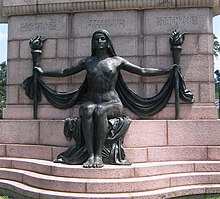Compton Hill Reservoir Park
History
James P. Kirkwood selected the site of the reservoir, one of the highest elevations within the 1855 city limits. As the reservoir occupied only 18 acres (7.3 ha) of the site, Kirkwood suggested the remaining land be turned into a park. The top of the reservoir structure was at one time covered with elevated tennis courts; presently, two newer tennis courts lie to the east.
The water tower was retired in 1929, after 30 years, when the Howard Bend Plant was put in service: the static head from the Stacy Park Reservoir, in what is now the St. Louis suburb of Olivette, caused an overflow of pure chemically treated water into the sewer system. The reservoir and water tower were renovated, in 1999, at a cost of $19 million.
In 1969, Interstate 44 was constructed through the northern edge of the park, reducing the area of the park to its present size.
Compton Hill Water Tower

The Compton Hill Water Tower, built in 1898, is the youngest of three remaining stand pipe-water towers in St. Louis. Whereas, in 1901, more than 423 stand pipe style water towers existed in the United States, as of 2008 only about a dozen remain standing, three of which are in St. Louis (the other two being the Bissell Tower and the Grand Avenue Water Tower). The 179-foot (55 m) tower was built to disguise a 6-foot (1.8 m) diameter, 130-foot (40 m) tall standpipe in its interior. The standpipe helped to control the dangerous surges in the city's pipes caused by the reciprocating pumps and maintain an even water pressure. The water tower was designed by Harvey Ellis who also had a hand in designing the headhouse for St. Louis Union Station. Occasionally, the observation deck at the top of the water tower is opened to the public, allowing visitors to see 360-degree panoramic views of the city. The Compton Hill Water Tower was declared a city landmark in 1966 and added to the National Register of Historic Places in 1972.
The Naked Truth

The statue The Naked Truth, unveiled in 1914, was a gift to the city of St. Louis by the German-American Alliance in honor of Carl Schurz, Emil Preetorius and Carl Daenzer, editors of the German St. Louis newspaper Westliche Post. Controversy erupted over the statue's nudity before the monument was even built when a jury selected the design of Wilhelm Wandschneider, the only non-local sculptor in the design contest. At the request of Adolphus Busch, who had contributed $20,000 of the $31,000 cost of the monument, the statue was made of bronze instead of white marble to deemphasize the nudity.
The statue was moved to its present location south of the water tower after Interstate 44 was constructed through the northern edge of the park. The statue was designated a city landmark in 1969.
See also
- Chicago Water Tower
- Louisville Water Tower
- Tower Grove East, St. Louis, nearby neighborhood that had a large German American population by the 1850s
- Tower Grove Park, the park located a short distance south on Grand Boulevard
References
- ^ "Compton Hill Reservoir Park". City of St. Louis. Retrieved 2008-05-21.
- ^ Schworm, William B. "A History of the St. Louis Water Works". City of St. Louis Water Division. Archived from the original on 2008-08-28. Retrieved 2008-06-17.
- ^ "National Register of Historic Places: Inventory - Nomination Form" (PDF). Missouri Department of Natural Resources. 1972-09-29. Retrieved 2008-05-30.
- ^ Hazelhurst, James Nisbit (1904). Towers and Tanks for Water Works (2nd ed. revised and enlarged ed.). New York: John Wiley & Sons. p. 9. OCLC 3704531. Retrieved 2008-06-16.
- ^ "Tower Openings". The Water Tower and Park Preservation Society. Archived from the original on 2008-06-13. Retrieved 2008-06-16.
- ^ "St. Louis Historic Preservation: Statue of the Naked Truth". City of St. Louis. Retrieved 2008-05-30.
External links
- Compton Hill Reservoir Park official site
- [1] Facebook page
- Compton Hill Water Tower - Compton Heights neighborhood page about the water tower
- The Water Tower and Park Preservation Society
- Built St. Louis: the Water Towers - Information about the three remaining water towers in St. Louis